Medication Administration Safety
The ultimate goal of healthcare practice is to deliver timely and safe medical support to patients.
Nurse practitioners and pharmacists are equipped with appropriate skills to ensure high-quality care is available to the greatest number of people.
Unfortunately, some challenges arise during the care delivery process. A good example is the occurrence of adverse drug events (ADEs). These are sentinel events associated with medication errors and interactions.
The prescription of wrong drugs or incorrect quantities will amount to medication error. Professionals in medical practice believe that safety and accuracy throughout the prescription process can be improved using appropriate strategies.
This presentation explains how measurement, technology, and teams can maximize medication administration safety.
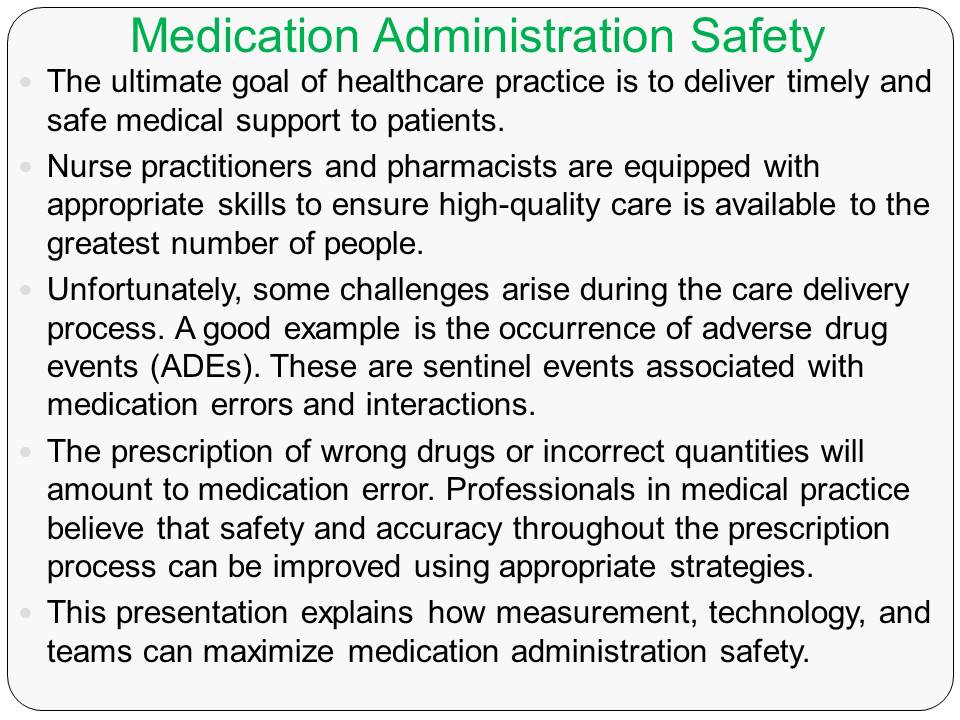
Topic Summary
Medication errors are common in a wide range of healthcare settings.
Experts in healthcare believe strongly that such events are caused by system or human factors.
Errors during medicine administration can result in problems such as drug-to-drug interactions, prolonged stays, increased health costs, and poor patient outcomes (Bonkowski et al., 2013).
The Institute of Medicine (IoM) has proposed specific practices and strategies that can be utilized to deal with these concerns.
For instance, systems change, use of technology, education for pharmacists and nurses, teamwork, measurements, and care delivery improvement have been suggested to minimize medication errors.
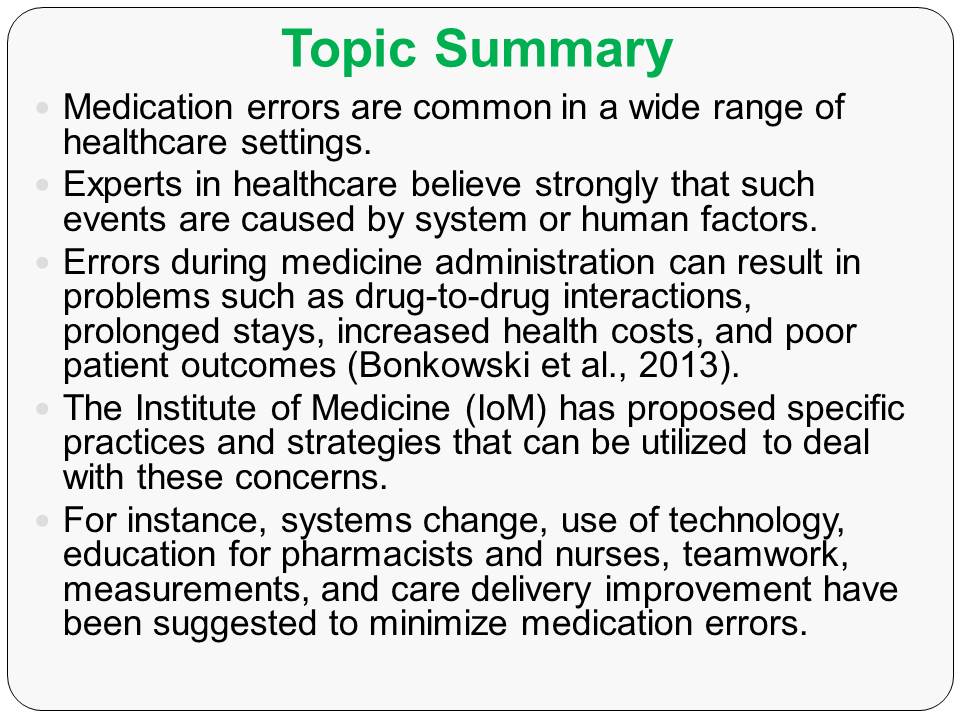
Measuring the Topic
Since medication errors occur in different settings, theorists have presented a standardized measurement to assess how they occur. Some of the common approaches focus on the types of administration systems.
Such models can be closed-loop, handwritten, or computerized (Parry, Barriball, & While, 2015).
Measurement tools use three aspects to determine the nature of a given medication error.
The first component is the interval between the start and the end time for prescribed drugs (Bonkowski et al., 2013).
The second aspect is the variance of inter-dose intervals.
The third feature is the proportion or quantity of drugs prescribed after a period of discontinuation (Parry et al., 2015).
These components guide analysts to determine if there has been a change in medication. They can also identify any potential impact or threat.
Charge nurses and managers can also consider the use of Regulatory Decision Pathway (RDP) models to identify the causes of medication errors and come up with improvements to maximize patient safety (Parry et al., 2015).
This tool guides managers to identify the major human factors that might have led to a medication error. Punishments and improvements are considered to prevent such events in the future.
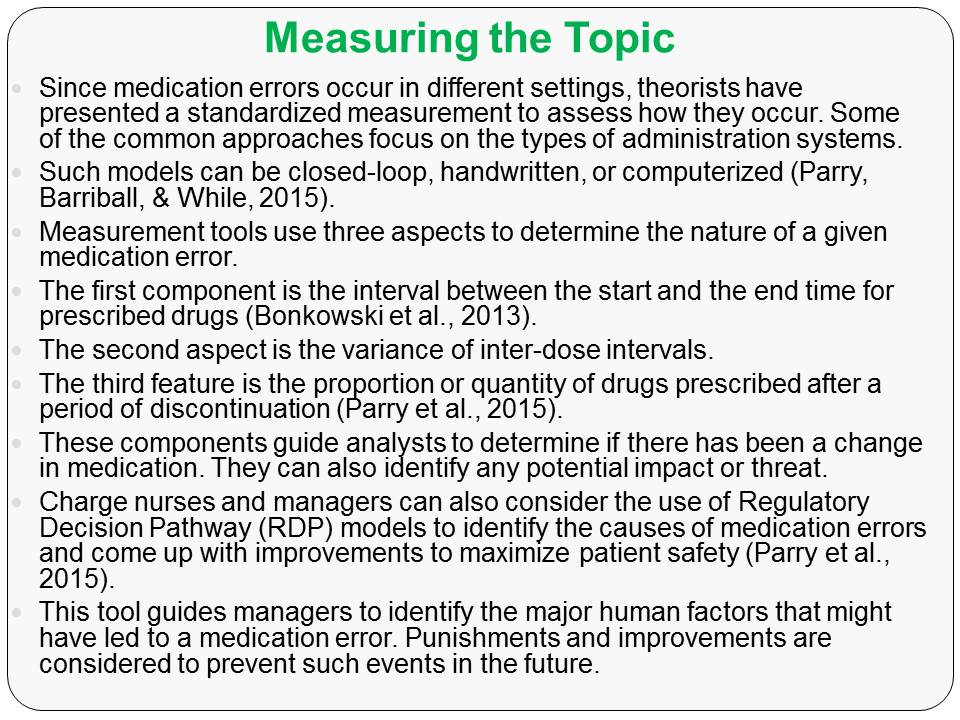
Importance of the Topic to Nursing Practice
The first importance of the targeted topic is that it seeks to present evidence-based approaches that can maximize the outcomes of every patient.
The discussion identifies some of the best interventions that can be utilized by caregivers and practitioners to prevent errors and other sentinel events.
This is a major achievement since such errors are known to affect the health outcomes of many patients (Bonkowski et al., 2013).
When nurses embrace most of the strategies suggested to improve medication safety, they will be in a position to transform their patients’ experiences and offer exemplary health services.
The topic will improve the manner in which nursing practice is executed to empower different patients.
The second advantage is that the topic presents diverse strategies that can have positive implications in the field of nursing.
For instance, concepts such as continuous learning, leadership, and teamwork are meaningful whenever planning to deal with medication errors.
Such practices can be embraced in different units to minimize errors and ensure the needs of every patient are met in a timely manner (Parry et al., 2015).
Similarly, such strategies can be applied in a wide range of nursing practices or units.
Furthermore, individuals who embrace the power of lifelong learning and teamwork will realize their goals much faster.
The insights gained from the topic can be used to develop superior nursing philosophies and meet the changing health needs of the global population.
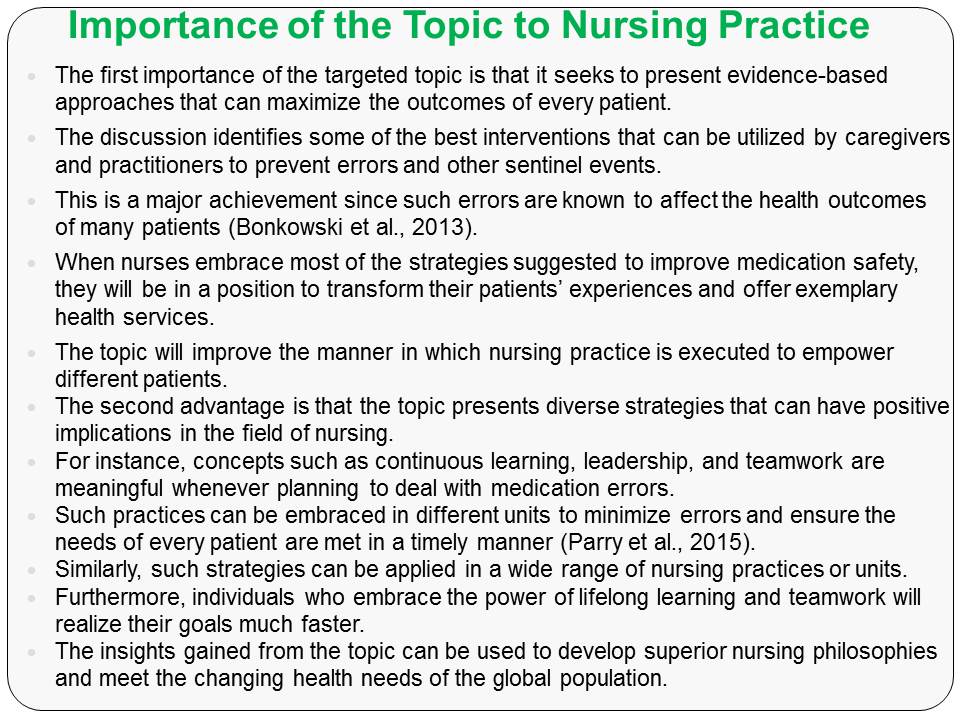
Effect of Team Collaboration
Jheeta and Franklin (2017) define collaboration as the process through which professionals undertaking complementary duties and responsibilities come together, share ideas, solve problems, and make decisions that can produce quality results.
In nursing practice, collaboration between nurses and caregivers can result in increased levels of awareness.
The professionals identify challenges and system factors that can catalyze medication errors.
The practitioners use their skills to make timely decisions and embrace the concept of continuous improvement.
Collaboration is a powerful attribute of teamwork. Parry et al. (2015) indicate that effective teams are associated with aspects such as trust, interaction, and respect.
The individuals collaborate, empower one another, and focus on the needs of their patients.
Effective communication minimizes differences and tragic consequences that might affect patient outcomes negatively (Hughes, 2008).
Nurses involved in the team will promote clarity and ensure various medication errors are omitted.
Disruptive behaviors are identified and reported to the relevant authorities.
Existing policies are communicated smoothly and followed by every nurse.
Team leaders embrace and promote desirable behaviors that can increase medication administration safety.
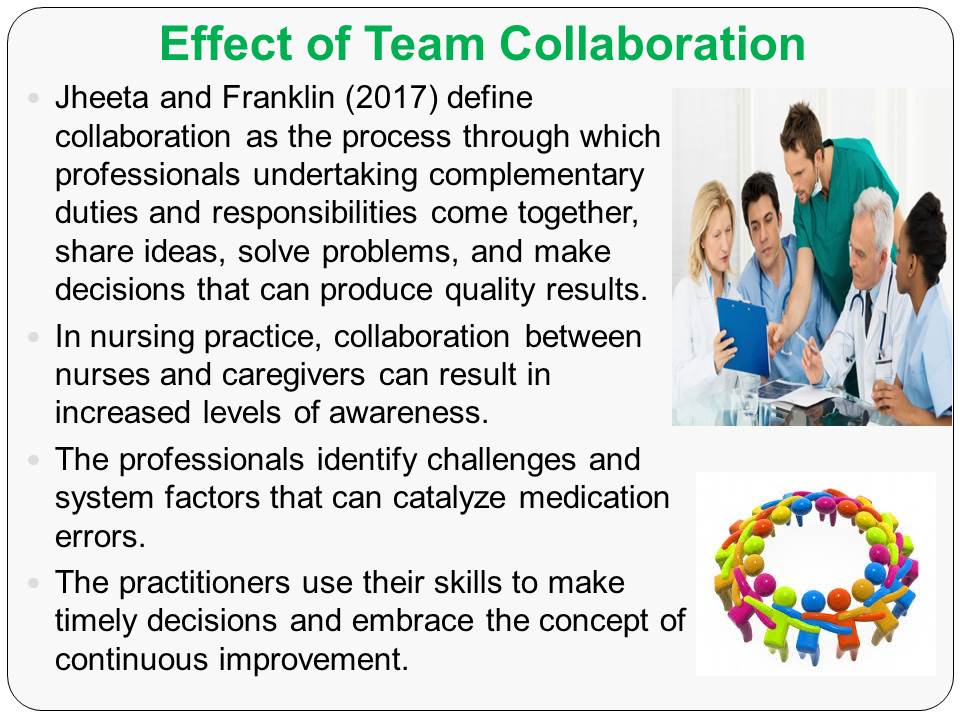
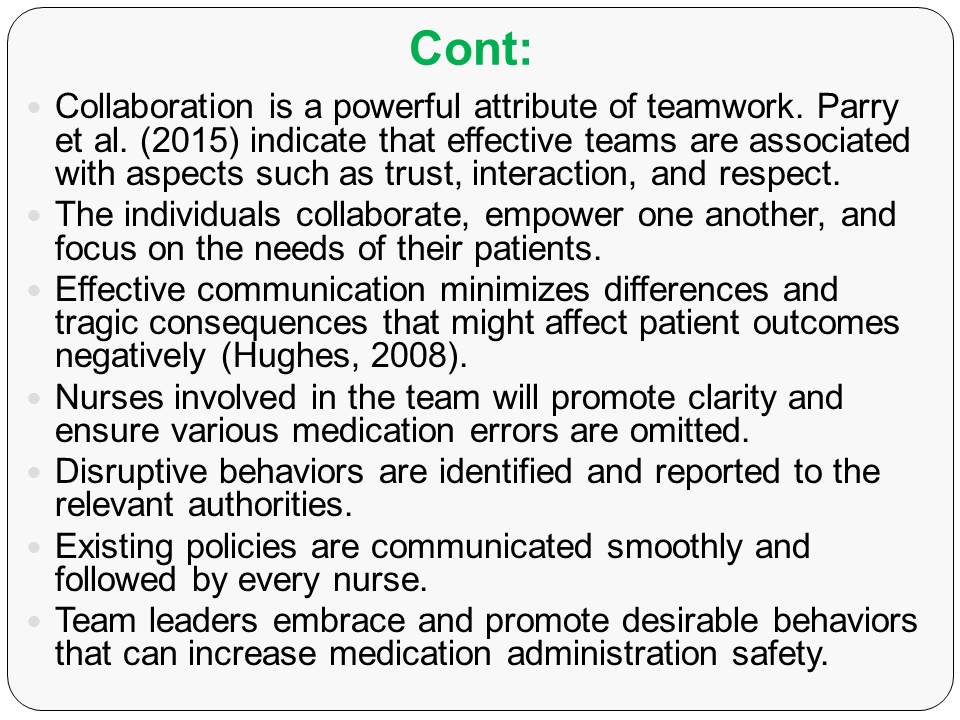
Influence of Health Care Technology
Computer and information technology (IT) specialists have presented numerous tools and procedures that can be applied in healthcare settings to maximize medication prescription accuracy and safety.
Medical IT experts have identified a number of innovations that can guide and empower nurses, physicians, and caregivers to minimize sentinel events.
For instance, the use of charting and decision support systems (DSSs) have been observed to improve the manner in which drugs are prescribed to the right patients (Bonkowski et al., 2013).
Such tools are capable of reducing the number of errors recorded in a given unit.
Jheeta and Franklin (2017) support the use of Bar-Coded Medication Administration (BCMA) technology whenever prescribing and administering various medicines.
The system is used to monitor drug administration processes and identify sources of medication errors. However, the technology has been observed to discourage nurses from reporting various sentinel events.
Patient education technology is known to empower and guide patients to take their drugs efficiently (Jheeta & Franklin, 2017).
Similar technologies can be used by nurses to monitor various drugs and administer them to the targeted patients.
Clinical decision support systems (CDSS) can improve the legibility and completeness of medicine orders (Bonkowski et al., 2013).
Drug interactions and allergies can also be reported instantly using such technologies.
Electronic surveillance systems, alerts, and reminders can inform nurses about the changing conditions of their patients.
The gathered information can ensure the right treatment is available to every patient.
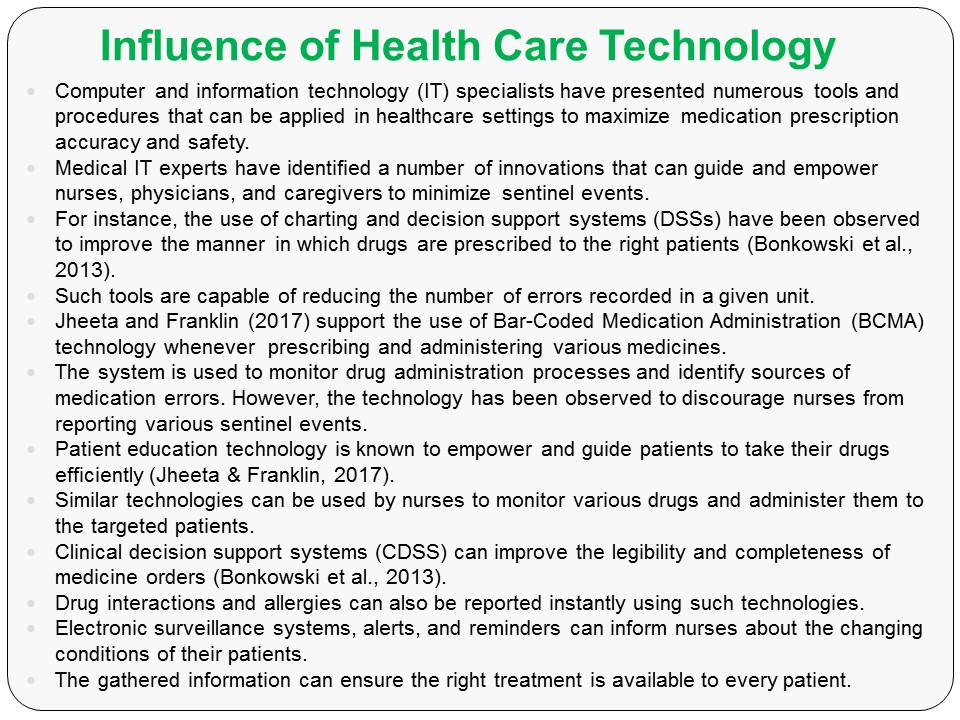
Conclusion
Patients seeking health care support should receive exemplary services from their nurse practitioners and facilities.
Unfortunately, medication errors have made it impossible for many individuals to record positive health outcomes.
A nursing unit characterized by collaboration, teamwork, and communication will be in a position to minimize such errors.
Additionally, the inclusion of modern technologies will ensure the right drugs are prescribed and administered to the targeted patients.
In conclusion, these practices present powerful models that can result in medication administration safety.
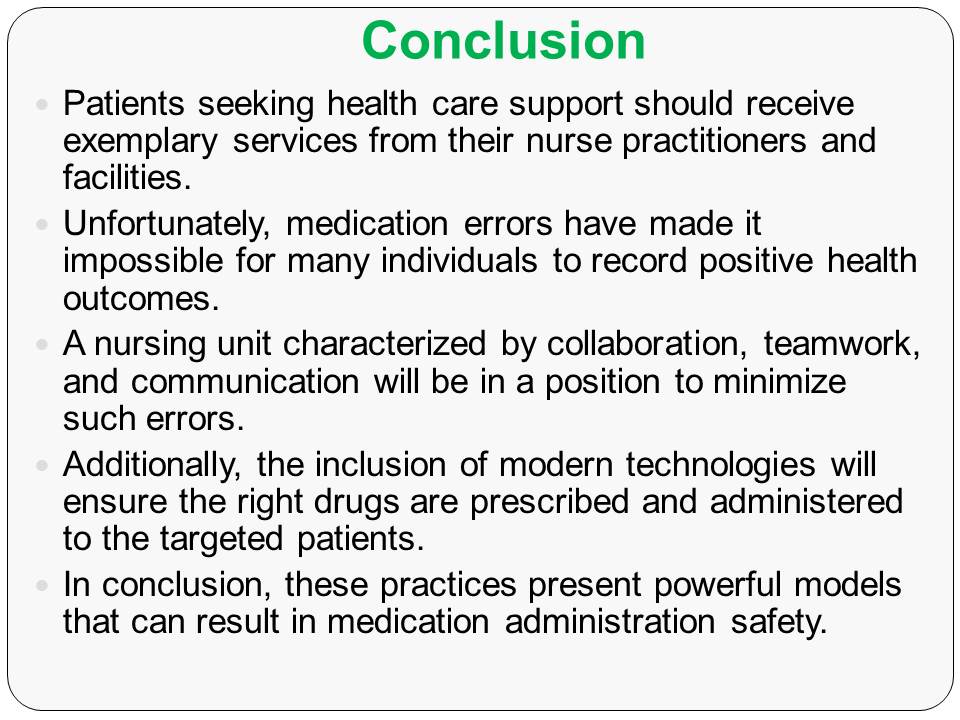
References
Bonkowski, J., Carnes, C., Melucci, J., Mirtallo, J., Prier, B., Reichert, E., … Weber, R. (2013). Effect of barcode-assisted medication administration on emergency department medication errors. Academic Emergency Medicine, 20(8), 801-806.
Hughes, R. H. (Ed.). (2008). Patient safety and quality: An evidence-based handbook for nurses. Rockville, MD: Agency for Healthcare Research and Quality.
Jheeta, S., & Franklin, B. D. (2017). The impact of a hospital electronic prescribing and medication administration system on medication administration safety: An observational study. BMC Health Services Research, 17(547), 1-10.Parry, A. M., Barriball, K. L., & While, A. E. (2015). Factors contributing to registered nurse medication error: A narrative review. International Journal of Nursing Studies, 52(1), 403-420.